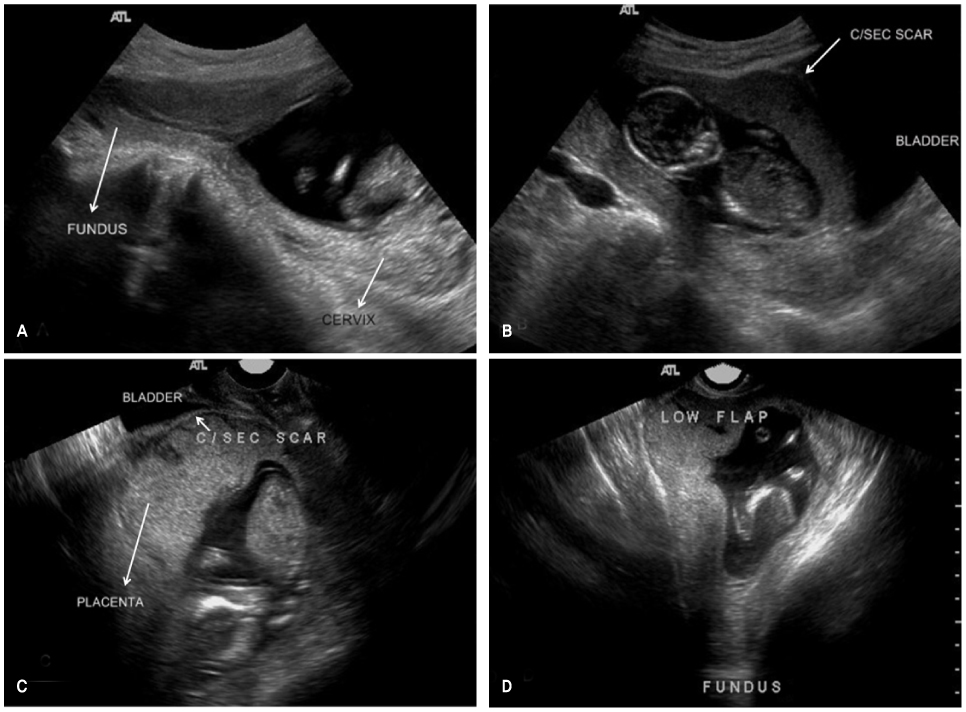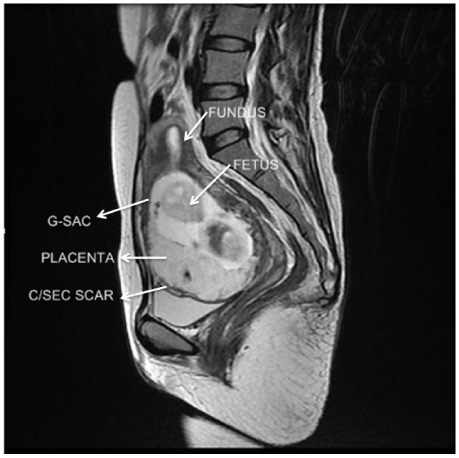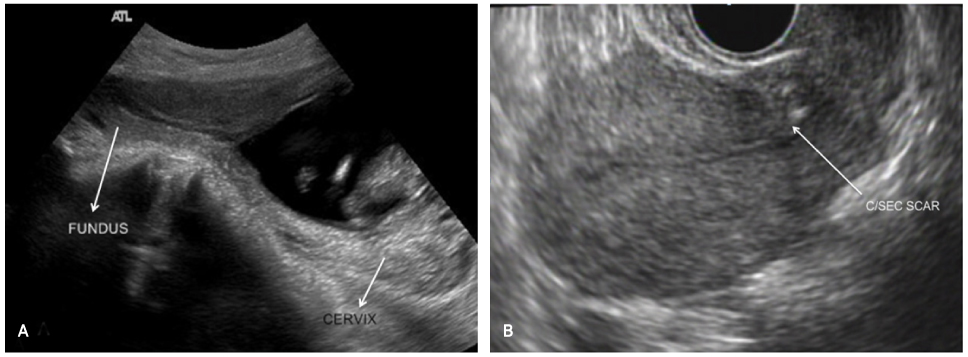Korean J Obstet Gynecol.
2010 Oct;53(10):934-939. 10.5468/kjog.2010.53.10.934.
Successful management of cesarean scar pregnancy at 13 weeks of gestation by uterine artery embolization: A case report
- Affiliations
-
- 1Department of Obstetrics and Gynecology, CHA Bundang Medical Center, CHA University School of Medicine, Seongnam, Korea. goodgood75@naver.com
- KMID: 1453759
- DOI: http://doi.org/10.5468/kjog.2010.53.10.934
Abstract
- Cesarean scar pregnancy, in which the pregnancy is implanted at the previous cesarean scar, is a very rare form of ectopic pregnancy. A delay in diagnosis can lead to uterine rupture, massive hemorrhage, and serious maternal morbidity. However, the optimal treatment is unknown. We experienced a case of viable cesarean scar pregnancy diagnosed at 13 weeks of gestation treated with uterine artery embolization and report with a brief of literatures.
MeSH Terms
Figure
Reference
-
1. Jurkovic D, Hillaby K, Woelfer B, Lawrence A, Salim R, Elson CJ. First-trimester diagnosis and management of pregnancies implanted into the lower uterine segment Cesarean section scar. Ultrasound Obstet Gynecol. 2003. 21:220–227.2. Seow KM, Huang LW, Lin YH, Lin MY, Tsai YL, Hwang JL. Cesarean scar pregnancy: issues in management. Ultrasound Obstet Gynecol. 2004. 23:247–253.3. Parente JT, Ou CS, Levy J, Legatt E. Cervical pregnancy analysis: a review and report of five cases. Obstet Gynecol. 1983. 62:79–82.4. Seow KM, Hwang JL, Tsai YL. Ultrasound diagnosis of a pregnancy in a Cesarean section scar. Ultrasound Obstet Gynecol. 2001. 18:547–549.5. Lee DH, Cho JS. Clinical analysis of intramural pregnancy. Korean J Obstet Gynecol. 2004. 47:856–862.6. Vial Y, Petignat P, Hohlfeld P. Pregnancy in a cesarean scar. Ultrasound Obstet Gynecol. 2000. 16:592–593.7. Roth G, Kleinstein J, Kuhnert A, Kunzel W. Nuclear magnetic resonance imaging of a patient with an ectopic pregnancy. Gynecol Obstet Invest. 1987. 23:135–140.8. Wright AR, English PT, Cameron HM, Wilsdon JB. MR pelvimetry: a practical alternative. Acta Radiol. 1992. 33:582–587.9. Fylstra DL. Ectopic pregnancy within a cesarean scar: a review. Obstet Gynecol Surv. 2002. 57:537–543.10. Ha HK, Jung JK, Kang SJ, Koong SE, Kim SJ, Kim JY, et al. MR imaging in the diagnosis of rare forms of ectopic pregnancy. AJR Am J Roentgenol. 1993. 160:1229–1232.11. Chou MM, Hwang JI, Tseng JJ, Huang YF, Ho ES. Cesarean scar pregnancy: quantitative assessment of uterine neovascularization with 3-dimensional color power Doppler imaging and successful treatment with uterine artery embolization. Am J Obstet Gynecol. 2004. 190:866–868.12. Chuang J, Seow KM, Cheng WC, Tsai YL, Hwang JL. Conservative treatment of ectopic pregnancy in a caesarean section scar. BJOG. 2003. 110:869–870.13. Hong JH, Jeong YA, Hwang JH, Kim JW, Lee KJ, Kim CH, et al. A case of successful treatment of an ectopic pregnancy embedded in the myometrium of previous cesarean section scar with systemic methotrexate injection. Korean J Obstet Gynecol. 2002. 45:1645–1648.14. Kim HJ, Lee KS, Han MY, Lee EH, Choi WY. Conservative management of intramural pregnancy implanting in the cesarean section scar. Korean J Obstet Gynecol. 2004. 47:1743–1747.15. Lee KS, Choi YM, Choi YS, Kim JY, Lee SH, Jee BC, et al. A case of ectopic pregnancy in a previous cesarean scar. Korean J Obstet Gynecol. 2005. 48:2723–2728.16. Ruano R, Kondo MM, Bunduki V, Rodeck C, Zugaib M. Follow-up of uteroplacental vascularization after feticide in third-trimester therapeutic termination of pregnancy with complete placenta previa. Ultrasound Obstet Gynecol. 2006. 27:463–465.17. Lobel SM, Meyerovitz MF, Benson CC, Goff B, Bengtson JM. Preoperative angiographic uterine artery embolization in the management of cervical pregnancy. Obstet Gynecol. 1990. 76:938–941.18. Spies JB, Ascher SA, Roth AR, Kim J, Levy EB, Gomez-Jorge J. Uterine artery embolization for leiomyomata. Obstet Gynecol. 2001. 98:29–34.19. Dutton S, Hirst A, McPherson K, Nicholson T, Maresh M. A UK multicentre retrospective cohort study comparing hysterectomy and uterine artery embolisation for the treatment of symptomatic uterine fibroids (HOPEFUL study): main results on medium-term safety and efficacy. BJOG. 2007. 114:1340–1351.20. Edwards RD, Moss JG, Lumsden MA, Wu O, Murray LS, Twaddle S, et al. Uterine-artery embolization versus surgery for symptomatic uterine fibroids. N Engl J Med. 2007. 356:360–370.
- Full Text Links
- Actions
-
Cited
- CITED
-
- Close
- Share
- Similar articles
-
- Successful conservative management of a viable Cesarean scar pregnancy: A case report
- Successful Conservative Management of Cesarean Section Scar Pregnancy
- A case of preoperative angiographic uterine artery embolization for the conservative treatment of cervical pregnancy
- Two pregnancy cases of uterine scar dehiscence after laparoscopic myomectomy
- A Case of Ectopic Pregnancy within a Previous Cesarean Scar




